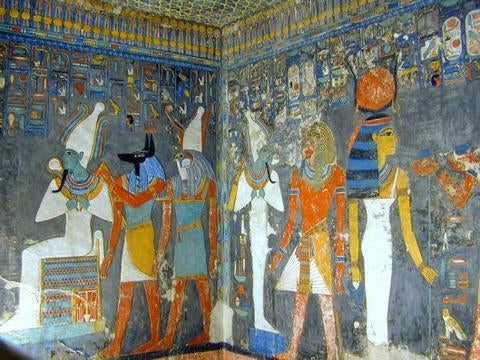The influence that Egypt has had on countless cultures is profound. Can you believe that the ancient Egyptian civilization lasted for more than 3000 years?
They were not only astounding innovators, but they discovered and advanced most of the arts and sciences that we have the privilege of knowing today. Art was incredibly important throughout their culture, and to this day we can still marvel at the preserved tombs, statuary, sculptures, complex pyramids, homes and buildings. Back in their day, all of the buildings, pyramids, sculptures, homes and walls were covered in color and paintings. It's hard to imagine those iconic yellow pyramids covered in a multitude of colors, but that was the rich world they lived in.

Egyptian artists depended on an array of natural materials. They were highly skilled miners who unearthed a variety of earth pigments, minerals, copper, bronze, silver and lead. They had extensive trading arrangements with overseas suppliers of dyes and pigments. They used precious stones such as Lapis Lazuli, which were imported from Afghanistan, and Azurite which were ground down to make a radiant blue. They heated lead ore which produced colors from white to red.
Red, orange, yellows and browns came
from iron oxide clays. Bright yellows came from orpiment (which was
highly toxic). White came from gypsum or chalk and black from carbon
(burned wood). Shades of green were prepared from minerals such as
Malachite, Chrysoprase and also their own invention - the acidic
corrosion of Copper.
They were the first humans to make a man-made pigment, now called "Egyptian Blue". Egyptian blue is a glass-like pigment which was made by heating together quartz sand, copper, calcium oxide, and an alkali such as natron, which was found naturally in the waters of Egypt. This crystalline material was ground into a pigment and made a luminous turquoise color. An Egyptian belief was that blue was considered the color of the heavens and the universe. It was also associated with water and the Nile.

They were known for using each element of nature in numerous ways. For example, they used a natural tree gum from the Acacia tree to create incense, perfume, paint, protective furniture covering, medicines and cosmetics. We use this same gum today as the binder in our Natural Earth Paint. The most common paints used were natural earth milk paints. Although, oils, waxes, resins, mastics, eggs, milk, lime and alcohol were also used as binders to craft a long list of paints and finishes.

So why on earth did we ever stop using natural earth pigments and binders for art purposes? (No pun intended). The amazing longevity and archival nature of natural pigments is evident simply by the preserved Egyptian art and artifacts we still have today. At Natural Earth Paint, we are committed to providing these same natural materials for the highest quality, easiest to use and most radiant art supplies available.

We are walking the paths of our ancestors to experience how historical cultures related to the world around them. By doing this, we become more conscious of and grateful for our natural resources and the properties of our products. Our pure Earth & Mineral Pigments are clay and mineral deposits that are prevalent in native soils all over the planet. By leaving out the modern-day preservatives, heavy metals, solvents, synthetics and fillers, our paints remain pure, radiant and archival just like our like-minded Egyptian inventor-artist ancestors.

Interested in learning more about Natural Earth Paint history? Visit our History page!
Follow us on Instagram, Facebook, and Pinterest for more natural inspiration.

